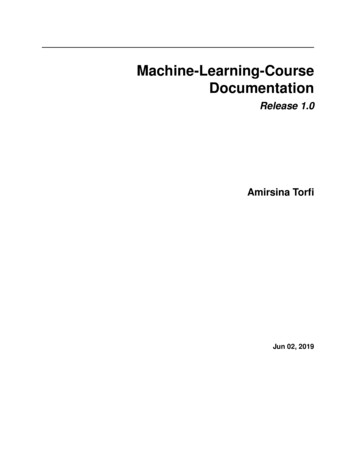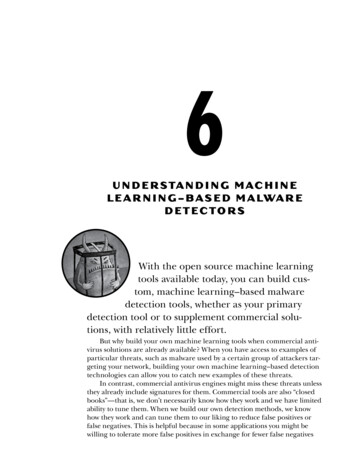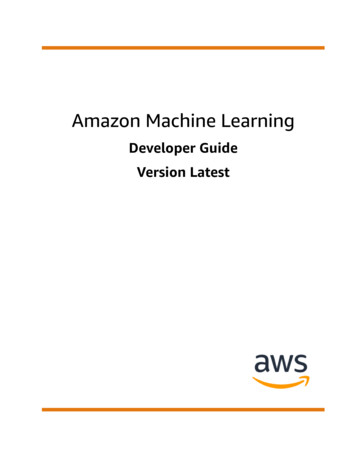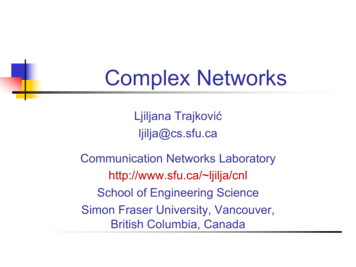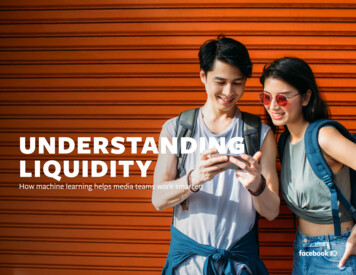
Transcription
How machine learning helps media teams work smarterFacebook IQ Understanding Liquidity1
WHAT IS LIQUIDITY ANDHOW DOES IT WORK?Back in 2006, NASA engineers faced a dilemma asaircraft became increasingly automated, leavingpilots to input commands and manage automationsequences. The team posed the following question:How do we find a balance between using increasinglypowerful technologies and retaining authority, withclear roles between humans and automation?The answer was the H-metaphor,1 a model forinteraction with intelligent machines akin to a horseand its rider. According to the H-metaphor, humanschart the course, then rely on machines to managereal-time calibrations—much like a rider who trusts hishorse to negotiate the terrain.In a sense, this is where we are with machine learningand media planning. Media planners accustomed tocrafting masterful plans have long been limited tosetting very narrow parameters for platform buys.Meanwhile, buyers accustomed to buying and servingads via automated systems still spend much of theirtime inputting, tweaking and honing campaigns. Withmyriad ever-changing data points to consider—forexample, audience targeting, market fluctuations,creative executions and placement options—thecalculus can become time-consuming.Facebook IQ Understanding Liquidity2
In such a fluid marketplace, machine learning helps to identify themost valuable impressions. When every dollar is allowed toflow to the most valuable impression, we call this condition“liquidity,” and it is made possible when humans taketheir hands off the controls and allow the system to readthe terrain.Machine learning uses algorithms to determine trends andrelationships within a dataset, which can be used for explainingobserved effects or predicting future outcomes in real time. Systemsbased on machine learning are able to evaluate opportunitiesfaster than any human being possibly could. In advertising, machinelearning allows media teams to automate the more tedious partsof their jobs, like deciding which calls to action work best for whichaudience, where to serve the ads and when.It’s understandable that marketers haven’t yet taken full advantageof this new technology. Algorithms can feel opaque, and somepeople worry that machine learning—and artificial intelligencein general—could make their roles disappear. But according toMcKinsey,2 the vast majority of positions can’t be fully automatedusing current technologies. By contrast, about a third of mosttasks that employees perform could be automated, improvingproductivity and freeing employees to focus on higher impact work.In this paper, we’ll explore just how machine learning enablesliquidity within automated campaign systems that allow buyingacross multiple locations and systems. We’ll also explore how bothplanning and buying teams can use this technology to run morecost-effective campaigns.Facebook IQ Understanding Liquidity3
UNDERSTANDINGHOW MACHINELEARNING WORKS INAUTOMATED SYSTEMSMachine learning makes this entire process much easier, as it supports systems that automate the processof finding the best buy. Machine learning models ingest behavioral data that consumers consent to provideto advertising platforms, website cookies or advertisers themselves. This data, which is anonymized andaggregated, is used to predict which groups of people will respond to an ad. Then, these models can selectwhich audiences (or groups of people) to show the ad to, and when. The more information provided tothe models, the better the predictions, and the better the system is able to identify and capture theimpressions that are most valuable for meeting the advertiser’s s is a natural evolution of today’s automatedbidding systems, which the digital media industry hasbeen using for more than a decade. But while traditionalexchanges were optimized solely for price and volume,machine learning allows for more complicatedcampaign optimizations.Traditional ad exchanges require buyers to bidon specific inventory shown to a predeterminedaudience and against a cost metric. So, if a plannerwanted to show a 250 x 250 banner ad to mothersof teenagers and pay no more than a 10 cost perthousand (CPM), a traditional exchange could dothat job. But when it’s time to evaluate performance,it might be unclear what about that ad performed—audience, placement or creative? To find out, amedia team might have to execute, run and analyzea dozen experiments before deciding on thebest buy.Facebook IQ Understanding Liquidity4
LEAVING MACHINESROOM TO RUNMedia planners accustomed to creating very detailedcreative iterations, placements, audiences and more—choose whether to restrict opportunities consideredmaps for client campaigns might be tempted toand ensure budgets are applied to find the right peoplefor delivery during the campaign. Setting as fewspecify who to target, where and with what creative.and produce the most cost-efficient results.restrictions as possible, thereby increasing liquidityBut planners can also use machine learning to surfaceon as many dimensions as possible, should confer theinsights and spark new ideas. To do so, they need toThe concept of cost per incremental outcome isallow the system to explore as many opportunities touseful in explaining exactly why this happens. Cost perfind value as possible, by setting broad parametersincremental outcome estimates how much it costs anwhenever they can. After the campaign runs,advertiser to change the attitude or behavior of a givenadvertisers can then use the system’s reporting tools toperson with an advertising campaign, and captures theretrieve insights. This allows learnings from campaignrelationship between campaign spend, ad effectivenessperformance to be surfaced without having to runand reach and frequency.many experiments manually.3Cost per incremental outcome In many cases, machine learning within automatedSpend/(Reach x Lift)systems can bring planners closer to success.Campaigns aiming for wide reach can run acrossIf done right, we expect increased liquidity to result inlarge audiences and platforms, allowing more choiceincreased reach, lift or a combination of the two, as theand accessing valuable and efficient impressions atsystem finds more or better opportunities to show thescale. When aiming for specific outcomes, marketersad for the same cost. Combined with constant campaignwho choose broad audience parameters and anspend, this often drives lower cost per outcome.agnostic approach to platforms can produce moreefficient conversions.In general, media teams can think about increasingliquidity on four main dimensions of a campaign:In every case, allowing machine learning algorithms toplacement, audience, budget and creative. Whileprocess as much data as possible improves liquidity.different advertising platforms present differentBy removing restrictions on a campaign, media teamschoices during campaign setup, these four dimensionscan test more opportunities simultaneously—includingare often nodes where planners and buyers mustgreatest benefit.HOW SHOULD I USEREPORTING?While reporting tools often show breakdownsby creative, demographics, placement orother dimensions, planners should evaluatethe success of the campaign by looking at theresults in aggregate. It may be tempting to lookat results and decide to exclude the worstperforming creative or placement in the nextcampaign. However, this is likely to result inworse campaign performance. An automatedsystem can see the distribution of prices inreal time, while a planner cannot, so it is able,for example, to shift delivery away from oneplacement if it is starting to experience rapidprice increases. As a result, even if one segmentappears to perform worse, delivering to thissegment was likely more cost-efficient thanthe next-best inventory from other segments.This issue is called the breakdown effect—learnmore with Facebook for Business.Facebook IQ Understanding Liquidity5
4 MAIN DIMENSIONSOF LIQUIDITYPLACEMENTIf the advertising platform includes multiplesurfaces, placement liquidity can be increasedby opting in to as many surfaces as possible.AUDIENCEAudience liquidity can be increased by targetingthe broadest possible audience.BUDGETBudget liquidity can be increased by removingrestrictions on where the campaign budget canbe spent. For example, setting the budget atthe campaign level instead of the ad level is oneway to increase budget liquidity.CREATIVECreative liquidity can be increased by allowingthe automated system to test and choose thebest-performing creative.Facebook IQ Understanding Liquidity6
Teams that use machine learning-enabledsystems can reap the benefits of increasedliquidity, namely more efficient setup andmore efficient campaigns.This isn’t to suggest that an automated systemis a magic bullet. For it to succeed, media buyersmust first identify a business goal to use in orderto assess which opportunities are most valuable,then pass this information to the system bysetting an optimization objective. The systemwill then listen for the appropriate signal thatthe goal is being achieved, and move budget andimpressions to different ad surfaces or audiencesthat give the maximum effect.What’s more, a system is only as good as thenetwork it runs across. Inventory quality, fraudprevention, brand safety protections and moreshould all be in place before you opt into anynetwork’s automated system. This is already partof any marketer’s due diligence, but concernsbecome magnified within automated systems. If,for example, a system is optimized toward clicks,accidental clicks could lead to high bounce ratesfrom the advertiser’s website, skewing results.Facebook IQ Understanding Liquidity7
CHOOSING SIGNALSWHAT’S A SIGNAL?A signal is a piece of consumer behavioral data that a machine-Marketers who entrust their campaigns to machine learningaren’t passengers on the road to success—they’re muchneeded captains who understand that reaching a businessobjective is more complicated than ever. Their insights andcontributions are invaluable in steering automated systemstoward the right outcome.learning model can use to make predictions about future behavior.For example, if consumers add specific items to their carts, this mayindicate they are likely to purchase in the future. Signals can comefrom a variety of sources such as through pixels (which can be setup for a range of events), software development kit (SDK) data thatindicates app installs or data for offline events like in-store sales.A critical step in campaign success is choosing the optimizationgoal and associated signal that best aligns with your businessgoal. For example, an online retailer who cares about purchasesshould set a goal (objective) of conversions and optimize fora purchase event. When customers engage with an ad in aspecific way—like adding an item to their cart—they’re alsosending a signal of purchase intent.For marketers with direct-response goals, these signals oftenalign closely with bottom-line objectives. App downloads,lead generation and online sales are all clear direct-responsesignals. By choosing an optimization signal that relates toyour business goals, you are opting for a machine-learningmodel aligned with what you want the campaign to achieve.Conversely, selecting a signal not directly related to businessgoals may produce unexpected results. For example, anadvertiser who chooses to optimize for link clicks might seea lower cost per click, but post-click conversions may suffer.Facebook IQ Understanding Liquidity8
By contrast, marketers running brand campaigns maynot have access to a signal closely aligned with bottomline objectives. Commonly used signals like videoviews might not track directly to true business goalssuch as raising sales. Further, there may be a trade-offbetween different metrics. For example, if a campaignis optimized on video views, an automated campaignthat is more liquid will deliver the cheapest cost perview—but may not deliver the highest reach.These secondary effects are not specific to automatedcampaigns but are a potential result of using higherfunnel metrics as a stand-in when lower-funnel metricsare not available.To determine which signal works best, brand marketersshould use lift testing to evaluate how well the proxymetric can serve their business goals. Advertiserscan also run a split test to see how well differentsignals work across a portfolio of metrics when usingautomated systems.Media buyers who understand what information anautomated system needs add value by finding thesignals that best deliver against their client’s goals.HOW CAN I TEST MY CAMPAIGN?Like an A/B test, split testing allows you to create multiple ad setsand test them against each other to see which strategies producethe best results. Split testing is good for comparing performanceto decide between two strategies. Lift testing, on the otherhand, shows the impact of an ad or campaign on business goals,compared to a world in which the campaign was not run. Learnmore about the difference—and how to set up an effective splittest—with online courses through Facebook Blueprint.Facebook IQ Understanding Liquidity9
WHAT IT MEANSFOR MARKETERSMedia planners and buyers play an essential role incrafting and executing platform campaigns. But even themost masterful can’t out-calculate a machine. And whywould they want to? Machine learning-driven systemssave time and effort when setting up campaigns,help maximize liquidity for the most efficient buy anduncover fresh insights that media teams can deliverto clients.REMEMBER THAT BROADER IS(USUALLY) BETTERPlanners are trusted by the clients for their vision andunderstanding of consumer audiences. They also addvalue by turning up unexpected insights. Automatedsystems underpinned by machine learning can do justthat by finding undiscovered pockets of efficiency thathelp clients reach goals faster and more cheaply.If you are targeting a necessarily narrow audienceor have other marketing guardrails, it’s important tounderstand that automated systems may not haveenough data to achieve the same results they otherwisemight. In these cases, the ability to navigate the medialandscape yourself is likely worth the additional cost.Facebook IQ Understanding Liquidity 10
WHAT IT MEANS FORMARKETERSOPT IN TO AUTOMATEDSYSTEMSGUIDE THE SYSTEMHow complicated are your objectives? If your goals areIs there a good signal that you, the advertiser, canunorthodox, you care about multiple brand metricsprovide to the system? This might be a true businessor you are courting a niche audience, you may not begoal, like lead generation or app downloads. If youable to provide the system with enough information tohave a strong signal, opt into automation withoutrealize your goals.additional testing.Further, how much control do you need? A manualIf not, how open are you to a trade-off betweensetup should give you control over something that’sdifferent campaign metrics? When you stray from yournot available in the automated system, like cappingbottom-line goals, you increase the chances that yourshares of delivery to a certain placement. If you don’toutcome may not drive your goals. If you have limitedneed to set those kinds of granular parameters, manualtolerance, try lift testing to see which strategy offers theoptimization could lead to a less-efficient campaign—best value, or split testing to get a quick read on howchoose automated instead.different optimizations affect a portfolio of metrics.FOOTNOTESKenneth H. Goodrich et al., “Application of the H-Mode, a Design and Interaction Concept for Highly Automated Vehicles, to Aircraft,” 25th Digital Avionics Systems Conference, October 15, nasa.gov/20060051774.pdf2James Manyika et al., “Jobs Lost, Jobs Gained: What the Future of Work Will Mean for Jobs, Skills and Wages,” McKinsey Global Institute, -of-work-will-mean-for-jobs-skills-and-wages3The level of information available in reporting tools varies by platform. In a Facebook-specific context, advertisers can use Ads Manager and Facebook Analytics for granular information about campaign performance.1Facebook IQ Understanding Liquidity 11
Facebook IQ Understanding Liquidity 12
Embedding machine learning within automated systems is a natural evolution of today's automated bidding systems, which the digital media industry has been using for more than a decade. But while traditional exchanges were optimized solely for price and volume, machine learning allows for more complicated campaign optimizations.







